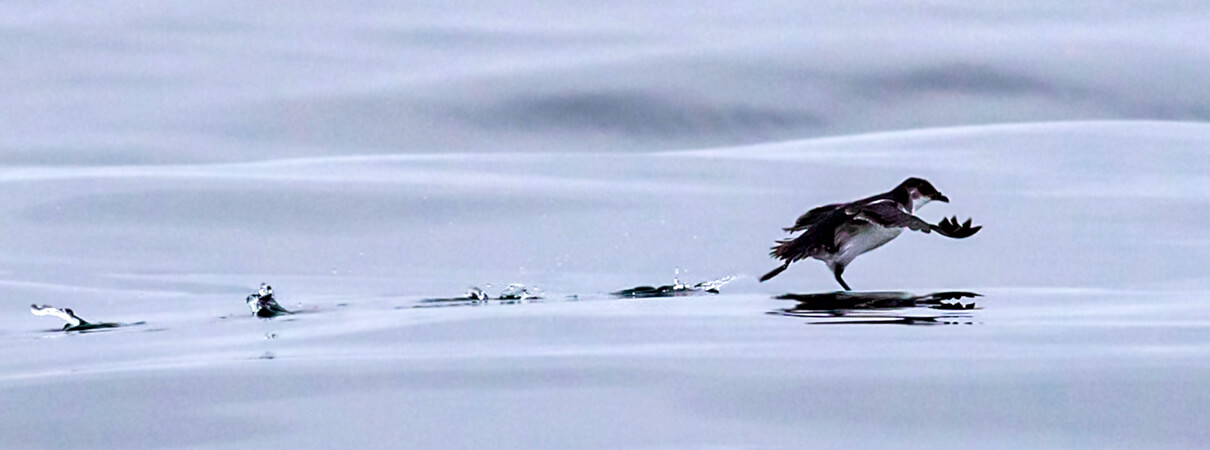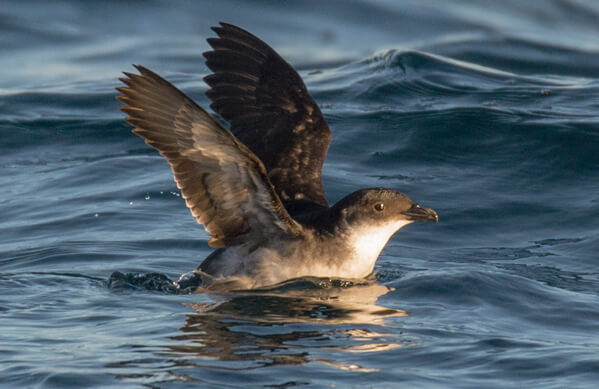
Peruvian Diving-petrel range map by Birds of North America, https://birdsna.org maintained by the Cornell Lab of Ornithology
At first glance, the Peruvian Diving-petrel is small — only about the length of an American Robin — and has a dark-and-light color pattern common to many other seabirds such as the Hawaiian Petrel and Townsend's Shearwater. Unlike petrels and shearwaters, though, diving-petrels are more aquatic than aerial, spending most of their time swimming.
Canary of Cold Seas
The Peruvian Diving-petrel lives in the cold waters of the Humboldt Current System (HCS), a nutrient-rich upwelling running along South America's west coast. The HCS is one of the planet's most productive ocean ecosystems, accounting for 18 to 20 percent of the total catch of sardines, anchovies, and jack mackerel worldwide. This high productivity supports many other birds, including the Waved Albatross and Inca Tern, along with seals and whales.
Once considered abundant, the Peruvian Diving-petrel has declined rapidly in recent decades due to a variety of manmade threats. It is now recognized as the first endangered seabird of the Humboldt Current System. This small bird's decline reflects dangers at its nesting colonies and also trouble in the larger HCS, which is losing its fabulous productivity due to warming waters — a result of global climate change.
Adapted to the Ocean
The Peruvian Diving-petrel is the largest of five diving-petrel species found throughout the Southern Hemisphere. These seabirds have a characteristic whirring flight, barreling so low over the ocean's surface that they sometimes cut through the crests of tall waves.
Underwater, like the Thick-billed Murre and Tufted Puffin, diving-petrels use their short, powerful wings as paddles, propelling themselves as they search for small fish, squid, and zooplankton such as krill.
Peruvian Diving-petrels have several other adaptations for hunting underwater, including an expandable gular (throat) pouch for storing food. Their genus name Pelecanoides derives from this feature, as it resembles the much larger pouch of pelicans, such as the Brown Pelican. They have nostrils that open upwards rather than pointing forward, another adaptation for diving. Peruvian Diving-petrels routinely dive to depths of 100 feet and have been recorded as deep as 270 feet.
Guano Bird
Like other pelagic birds, the Peruvian Diving-petrel comes to land only to breed. Its traditional nesting islands off the coasts of Chile and Peru were once covered with hundreds of years' worth of bird droppings, or guano. The Peruvian Diving-petrel digs a deep nest burrow in this substrate, where it lays a single egg. It will also tunnel into sandy soils, or even nest in rock crevices.
Guano is a highly valued fertilizer that had been harvested sustainably by the Inca for many years. After Europeans discovered this resource in the 19th century, they began mining tons of guano from offshore nesting islands. As these seabird nesting sites were stripped bare, diving-petrels were left with no place to breed. Uncontrolled guano mining destroyed eggs and chicks as well as nest burrows, and miners also harvested birds and eggs for food.

Peruvian Diving-petrel by abriendomundo, Shutterstock
Natal Attraction
The Peruvian Diving-petrel once numbered in the millions, but their numbers crashed following years of guano extraction and the depredations of introduced predators such as foxes and feral cats, along with habitat-destroying rabbits. Warming ocean temperatures caused by climate change also contributed to its sharp decline. At one time, the majority of the population nested on 13 islands, but today this has been reduced to five.
Although this seabird's known Peruvian breeding sites lie within protected areas (Paracas National Reserve and Guano Islands National Reserve), some guano extraction still continues there, and the reserves are inadequately protected and monitored.
In 2019, with support from ABC, Island Conservation and Chile's National Forestry Corporation (CONAF) installed a social-attraction system on Chile's Chañaral Island to induce Peruvian Diving-petrels to return there to nest. Chañaral was formerly the site of the largest known colony, but the birds had been absent for decades after the introduction of non-native foxes and rabbits.
To everyone's delight, Peruvian Diving-petrels began investigating the island almost immediately, and although there has been no confirmed re-nesting yet, hopes are high that the island will once again support a healthy colony of this interesting little seabird.
Donate to support ABC's conservation mission!



















































